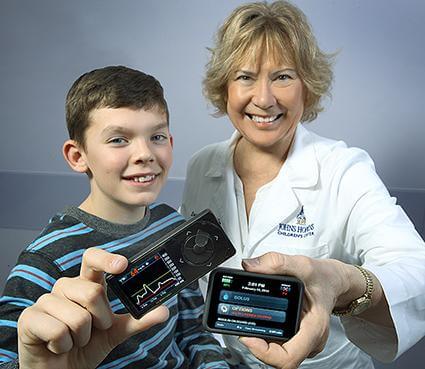
In the Pediatric Diabetes Clinic at the Johns Hopkins Children’s Center, James Conway, 12, is learning how to use his new insulin pump. The size of a small pager, it will replace the older, larger one in the belt clip. He’s introduced to a small continuous glucose monitoring sensor. Worn on the body, typically on the abdomen, it checks blood sugar every five minutes.
Pediatric diabetes nurse educator Loretta Clark tells him and his mother, Denise Conway, “It will transmit the same information wirelessly so we can see what’s going on and help you manage.”
Teaching patients and families how to manage diabetes and all its related and ever-changing technology is what Clark does. A disease of numbers, diabetes requires close scrutiny of multiple factors in a patient’s life. Diabetes management, Clark says, is “more of an art than a science. There are so many daily variables that make blood sugar change. Every minute of the day, blood sugar is going up and down. Families need the skills and confidence to manage this.”
A disorder of the immune system, type 1 diabetes is due to a loss of pancreatic insulin secretion, affecting several metabolic functions, most notably glucose metabolism. Type 1 usually appears suddenly in childhood and is life-long. While the disorder can be controlled with insulin, such management requires vigilance and a strict regimen of care.
Clark is available to families on a fulltime basis thanks to an endowment created in 2007 with gifts from Richard and Kathryn Radmer and the Nicholls Family Foundation to ensure that the education and support the pediatric nurse provided to them and their own families would be available to those who followed. Clark is the inaugural recipient of the Pediatric Diabetes Nurse Educator Endowment at Johns Hopkins.
“Loretta has been a vital lifeline for us,” says Tom Johnson, whose sons, Nick and James, were diagnosed with type 1 diabetes at the ages of 2 and 12, respectively. “She is at the vanguard of diabetes care and urges us ever onward to adopt the newer therapies. She has helped our now teenage sons learn to manage their condition. When you’re dealing hourly, daily with pumps, insulin, syringes, measuring and worry for your kids and your own proficiencies, the diabetes nurse educator has to be someone who does it all–who is a nutritionist, endocrinologist, technologist, coach and cheerleader. Loretta is all of these, and more.”
Today, Clark and fellow pediatric diabetes nurse educator Kimber-Lee Abel care for more than 400 children in the clinic, leading the education and training so critical to the health and lives of children with diabetes. In partnership with pediatric endocrinologists like Leslie Plotnick, co-founder with Clark of the Pediatric Diabetes Clinic at Johns Hopkins, the nurse educators work around the clock with families to help them manage and cope with the endless schedule of measuring, dosing and calculating.
While the technology to help diabetes patients is improving, the sheer number of children with type 1 or type 2 diabetes – the latter chiefly associated with diet and lifestyle–are increasing. Virtually unseen in children a few decades ago, cases of type 2 are shadowing the rising rates of obesity in kids, now at epidemic levels. The diabetes clinic at Johns Hopkins Children’s Center is always full.
“We need more nurse educators,” says Plotnick, the clinic’s director, “and more endowments to fund them. The need is critical.”
Because there’s no “cure” for diabetes, the best therapies are still primarily those that control symptoms, hopefully mitigating some of the disease’s profound consequences, which include kidney and nerve damage, heart disease and stroke.
“We endocrinologists would have no time to follow more than a handful of diabetes patients, without the consistent expertise of our nurse educators, given the incredible complexity in managing this illness,” Plotnick continues. “But it can be managed well, if done properly.”
Stacie Peddy knows both the challenge and power of proper management. “We called Loretta at least once a day in the first months after our daughter, Brynn, was diagnosed with type 1 at Johns Hopkins,” says Peddy, a pediatric cardiac intensivist at Children’s Hospital of Philadelphia, and a former resident and fellow at Johns Hopkins. “We’d fax her Brynn’s blood glucose levels and she’d tell us how to tweak things. It was overwhelming for me, and I’m a physician. I don’t know how Leslie could do what she does without her nurse educators. Brynn is doing beautifully today.”
To help ensure that young patients’ diabetes is safely managed when they are away from home and parents and in school, Clark and Abel offer education and guidance to school nurses. Also, with Plotnick and a team of pediatric endocrinologists, nutritionists and psychologists, they focus on diabetes prevention.
(Photo above: With insulin pumps in hand, pediatric diabetes nurse educator Loretta Clark with a patient, James Conway.)
Make an Appointment in Our Pediatric Diabetes Clinic: Evaluations and clinical care, in our Division of Pediatric Endocrinology.
How You Can Help: Would you like to join our philanthropic effort in pediatric diabetes, including endowment of a nurse educator? Contact the Office of Development at Johns Hopkins Children's Center, 410-361-6493
Facts about Diabetes Mellitis
This article, by Wendell Smith, appears in the summer 2014 issue of Hopkins Children's Magazine.
